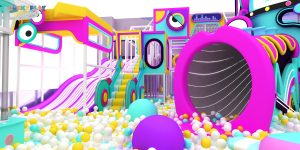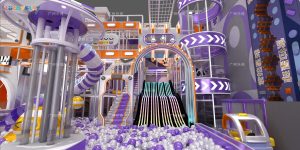Creating a safe and engaging indoor playground goes far beyond choosing fun equipment. It requires a solid understanding of indoor playground installation standards that guarantee both safety and regulatory compliance. For business owners, ensuring your setup meets these requirements is critical—not just for safety, but for long-term trust and reputation.
1. Hire Certified Indoor Playground Installation Experts
Installing indoor playground equipment is not a DIY project. It should only be done by trained, certified technicians who understand both the manufacturer’s specifications and industry safety codes.
- Key Considerations:
- Professionals ensure equipment is properly anchored, leveled, and secured
- Technicians are familiar with local and national regulations
- Improper installation can lead to serious injury and legal liability
Pro tip: Always request proof of certification and previous installation references.
2. Use Certified and Tested Indoor Playground Equipment
The first step toward a safe indoor playground is choosing certified, safety-tested equipment from trusted suppliers.
- Look for Certifications Including:
- ASTM F1918-12: Standard for soft-contained indoor play equipment
- NFPA 701: Fire resistance
- UL 94: Flammability
- Non-toxic and lead-free materials
Using reliable equipment ensures your investment is not only durable but also safe for children of all ages.
3. Ensure Proper Spacing, Surfacing, and Fall Zones
Safety doesn’t end with equipment quality—it’s also about how it’s arranged.
- Spacing Between Structures
- Maintain clear pathways between play zones
- Prevent collision risks by spacing moving components apart
- Fall Zones
- Each play structure must have an impact-absorbing fall zone
- Use suitable surfaces like rubber mats or foam tiles
- Surfacing depth must match equipment height (per safety guidelines)
- Avoid Entrapment and Entanglement Hazards
- All gaps must prevent head or body entrapment
- Eliminate protruding bolts, open hooks, and sharp edges
- No ropes or cords that could tangle clothing or pose choking risks
4. Schedule Regular Maintenance and Safety Inspections
Installation is just the beginning. Ongoing care is essential to maintain a safe indoor playground environment.
- Daily Maintenance Checklist:
- Check for loose bolts, broken parts, or sharp edges
- Remove any debris or spills
- Test all moving parts and sensor-based features
- Monthly or Quarterly Inspections:
- Review wear-and-tear on surfaces
- Inspect all equipment stability
- Reassess compliance with safety standards
Create a documented maintenance schedule to satisfy insurance requirements and enhance trust among parents and stakeholders.
Final Thoughts: Safety Builds Trust and Business Growth
By strictly following indoor playground installation standards, you’re not just building a fun environment—you’re building a reliable, trusted brand. A well-installed, well-maintained playground reflects your business’s commitment to:
- Child safety
- Professionalism
- Regulatory compliance
- Long-term customer loyalty





